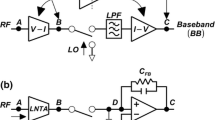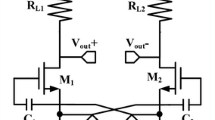Abstract
A wideband low-noise transconductance amplifier (LNTA) with high linearity is proposed. The differential LNTA adopts complementary common-gate (CG), current mirror (CM) and common-source (CS) schemes to obtain noise and distortion cancellation, and \(g_{m}\)-enhancement. A high third-order input intercept point (IIP3) is obtained due to the distortion cancellation and the complementary characteristics of NMOS and PMOS transistors. The gain expansion of the class-AB CS stage compensates the gain compression of the CG–CM stage, which leads to a high large-signal linearity. A wide input matching bandwidth is achieved by utilizing a \(\uppi \)-type input matching network without the use of on-chip bulky inductors, and the passive voltage gain of the \(\uppi \)-network further enhances the effective transconductance. Designed in a 0.18-\(\upmu \hbox {m}\) CMOS process, the simulation results show that it provides a minimum noise figure (NF) of 2.95 dB and a maximum transconductance of 79 mS from 0.1 to 3.6 GHz. An input 1-dB compression/desensitization point and an IIP3 of 8.1/5.59 and 18.14 dBm are obtained, respectively. The NF is degraded by 0.3 dB with a 0-dBm blocker. The circuit draws 10.7 mA from a 2.5-V supply, and the core area is only \(0.5 \times 0.12\,\hbox {mm}^{2}\).



















Similar content being viewed by others
References
V. Aparin, L.E. Larson, Modified derivative superposition method for linearizing FET low-noise amplifiers. IEEE Trans. Microw. Theory Tech. 53, 571–581 (2005)
J.Y. Bae, S. Kim, H.S. Cho, I.Y. Lee, D.S. Ha, S.G. Lee, A CMOS wideband highly linear low-noise amplifier for digital TV applications. IEEE Trans. Microw. Theory Tech. 61, 3700–3711 (2013)
S.C. Blaakmeer, E.A.M. Klumperink, D.M.W. Leenaerts, B. Nauta, A wideband noise-canceling CMOS LNA exploiting a transformer, in IEEE Radio Frequency Integrated Circuits Symposium, pp. 156–159 (2006)
S.C. Blaakmeer, E.A.M. Klumperink, D.M.W. Leenaerts, B. Nauta, Wideband balun-LNA with simultaneous output balancing, noise-canceling and distortion-canceling. IEEE J. Solid-State Circuits 43, 1341–1350 (2008)
F. Bruccoleri, E.A.M. Klumperink, B. Nauta, Noise cancelling in wideband CMOS LNAs, in IEEE International Solid-State Circuits Conference, pp. 406–407 (2002)
F. Bruccoleri, E.A.M. Klumperink, B. Nauta, Wide-band CMOS low-noise amplifier exploiting thermal noise canceling. IEEE J. Solid-State Circuits 39, 275–282 (2004)
W.H. Chen, G. Liu, B. Zdravko, A.M. Niknejad, A highly linear broadband CMOS LNA employing noise and distortion cancellation. IEEE J. Solid-State Circuits 43, 1164–1176 (2008)
Y. Cheng, C. Hu, MOSFET Modeling & BSIM3 User’s Guide (Springer, New York, 2002)
Y. Ding, R. Harjani, A high-efficiency CMOS+ 22-dBm linear power amplifier. IEEE J. Solid-State Circuits 40, 1895–1900 (2005)
H.M. Geddada, C.T. Fu, J. Silva-Martinez, S.S. Taylor, Wide-band inductorless low-noise transconductance amplifiers with high large-signal linearity. IEEE Trans. Microw. Theory Tech. 62, 1495–1505 (2014)
D.G. Im, S.S. Song, H.T. Kim, K. Lee, A wide-band CMOS variable-gain low noise amplifier for multi-standard terrestrial and cable TV tuner, in IEEE Radio Frequency Integrated Circuits Symposium, pp. 621–624 (2007)
D. Im, I. Nam, H.T. Kim, K. Lee, A wideband CMOS low noise amplifier employing noise and IM2 distortion cancellation for a digital TV tuner. IEEE J. Solid-State Circuits 44, 686–698 (2009)
D. Im, I. Nam, K. Lee, A low power broadband differential low noise amplifier employing noise and IM3 distortion cancellation for mobile broadcast receivers. IEEE Microw. Wirel. Compon. Lett. 20, 566–568 (2010)
E.A. Keehr, A. Hajimiri, A wide-swing low-noise transconductance amplifier and the enabling of large-signal handling direct-conversion receivers. IEEE Trans. Circuits Syst. I: Regul. Pap. 59, 30–43 (2012)
M. Mehrpoo, R.B. Staszewski, A highly selective LNTA capable of large-signal handling for RF receiver front-ends, in IEEE Radio Frequency Integrated Circuits Symposium, pp. 185–188 (2013)
A. Mirzaei, H. Darabi, J.C. Leete, X. Chen, K. Juan, A. Yazdi, Analysis and optimization of current-driven passive mixers in narrowband direct- conversion receivers. IEEE J. Solid-State Circuits 44, 2678–2688 (2009)
A. Mirzaei, H. Darabi, A. Yazdi, Z. Zhou, E. Chang, P. Suri, A 65 nm CMOS quad-band SAW-less receiver SoC for GSM/GPRS/EDGE. IEEE J. Solid-State Circuits 46, 950–964 (2011)
D. Murphy, H. Darabi, A. Abidi, A.A. Hafez, A. Mirzaei, M. Mikhemar, M.C.F. Chang, A. Blocker-Tolerant, Noise-cancelling receiver suitable for wideband wireless applications. IEEE J. Solid-State Circuits 47, 2943–2963 (2012)
I. Nam, B. Kim, K. Lee, CMOS RF amplifier and mixer circuits utilizing complementary characteristics of parallel combined NMOS and PMOS devices. IEEE Trans. Microw. Theory Tech. 53, 1662–1671 (2005)
B. Razavi, RF Microelectronics, 2nd edn. (Prentice Hall, New Jersey, 2011)
Z. Ru, N.A. Moseley, E. Klumperink, B. Nauta, Digitally enhanced software-defined radio receiver robust to out-of-band interference. IEEE J. Solid-State Circuits 44, 3359–3375 (2009)
W.M.C. Sansen, Analog Design Essentials (Springer, Dordrecht, 2006)
M. Valla, G. Montagna, R. Castello, R. Tonietto, I. Bietti, A 72-mW CMOS 802.11a direct conversion front-end with 3.5-dB NF and 200-kHz 1/f noise corner. IEEE J. Solid-State Circuits 40, 970–977 (2005)
C.Y. Yu, I.S.C. Lu, Y.H. Chen, L.C. Cho, C.H.E. Sun, C.C. Tang, H.H. Chang, W.C. Lee, S.J. Huang, T.H. Wu, C.S. Chiu, G. Chien, A SAW-less GSM/ GPRS/EDGE receiver embedded in 65-nm SoC. IEEE J. Solid-State Circuits 46, 3047–3060 (2011)
Author information
Authors and Affiliations
Corresponding author
Appendix Volterra Series Analysis
Appendix Volterra Series Analysis
To capture high-frequency effect, Volterra series analysis is performed as below. Referring to Fig. 8 and repeating (9)–(10) for \(V_{x}\) and \(V_{1}\),
Applying Kirchhoff’s current law at each node of the circuit in Fig. 8, the following equations can be obtained:
where \(Z_x (s)=\frac{1}{sC_x }\), \(Z_1 (s)=R_1 \left\| {\frac{1}{sC_1 }} \right. \), and \(Z_{a}\) is given in (8). \(g_{m1} \), \({g}'_{m1} \) and \({g}''_{m1} \) are given in (1).
To find the linear transfer functions \(A_1(s)\) and \(B_1 (s)\), we excite the circuit with a single tone \(v=e^{st}\). Substituting (12) and (13) in (14) and (15), equating the coefficients of \(e^{st}\) on both sides of (14) and (15), and solving for \(A_1 (s)\) and \(B_1 (s)\), we get
where
To find the second-order term \(A_2 (s_1 ,s_2 )\) and \(B_2 (s_1 ,s_2 )\), we excite the circuit with two tones \(v=e^{s_1 t}+e^{s_2 t}\). Substituting (12) and (13) in (14) and (15), equating the coefficients of \(e^{(s_1 +s_2 )t}\) on both sides of (14) and (15), and solving for \(A_2 (s_1 ,s_2 )\) and \(B_2 (s_1 ,s_2 )\), we get
Likewise, \(A_3 (s_1 ,s_2 ,s_3 )\) and \(B_3 (s_1 ,s_2 ,s_3 )\) are given by
where
For the common-source stage and current mirror output stage, the parasitic capacitances and output impedances of \(M_{2}\) and \(M_{4}\) can be ignored since the load resistance \(R_\mathrm{L}\) is small enough, and the memoryless Taylor series is applied to reduce the analysis complexity. The output current can be expressed as
where \(g_{m2} \), \(g_{m4} \), \({g}'_{m2} \), \({g}'_{m4} \), \({g}''_{m2}\) and \({g}''_{m4} \) are given in (1).
Plugging in the above Volterra kernel expressions, the fundamental and third-order output current \(i_{o}\) expressions are found to be
Rights and permissions
About this article
Cite this article
Chen, J., Guo, B., Zhang, B. et al. A Highly Linear Wideband CMOS LNTA Employing Noise/Distortion Cancellation and Gain Compensation. Circuits Syst Signal Process 36, 474–494 (2017). https://doi.org/10.1007/s00034-016-0320-9
Received:
Revised:
Accepted:
Published:
Issue Date:
DOI: https://doi.org/10.1007/s00034-016-0320-9




